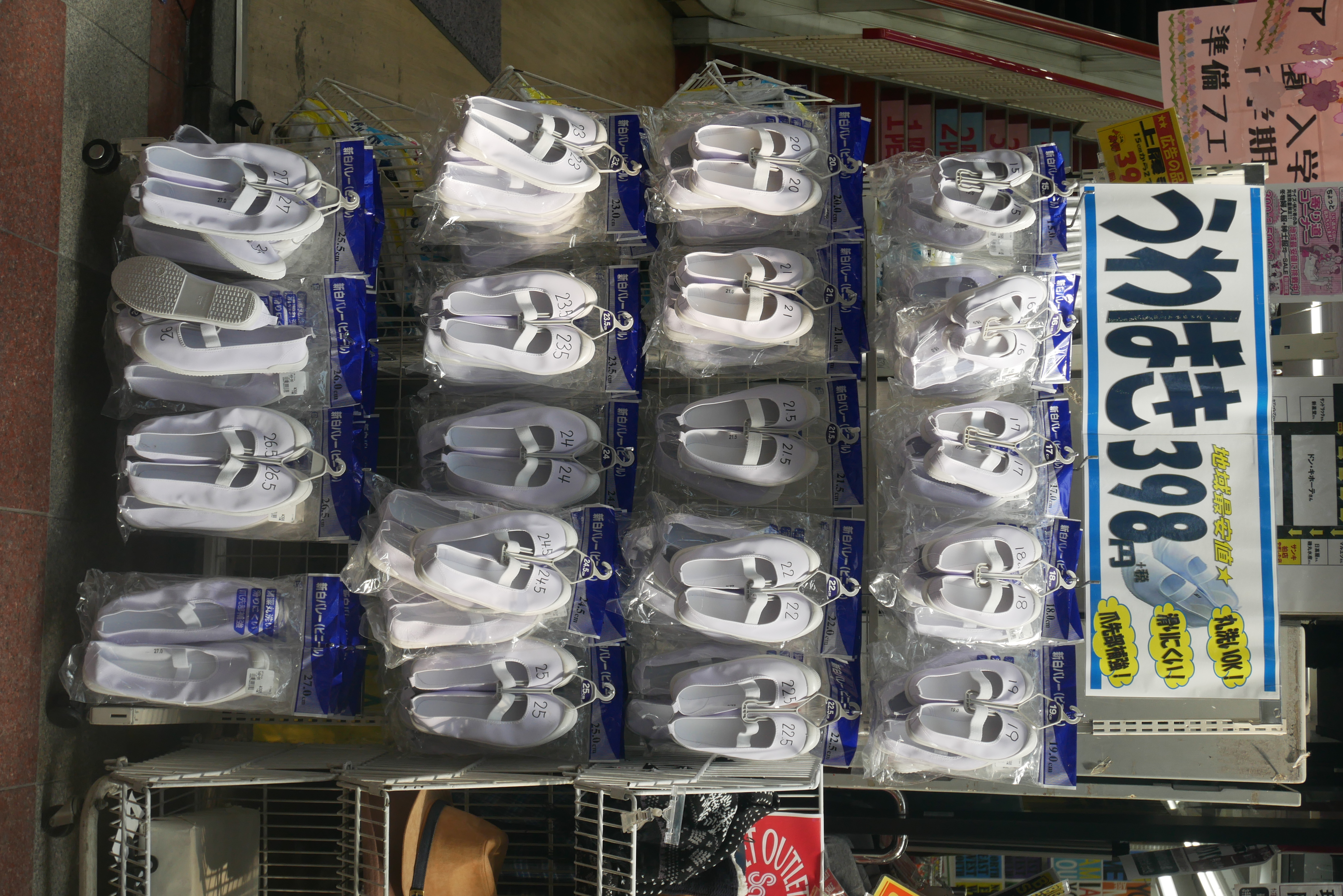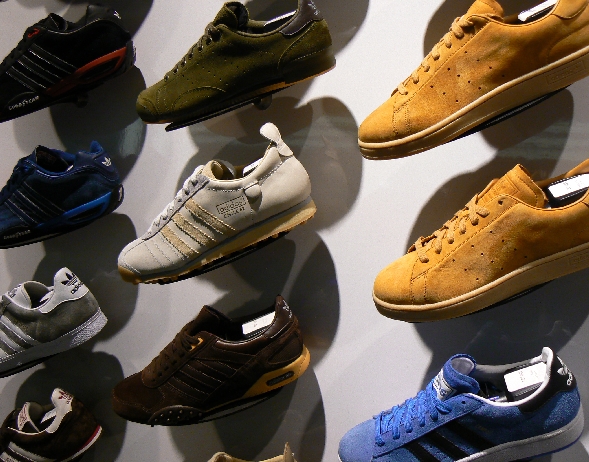|
Uwabaki
are a type of Japanese slippers worn indoors at school or certain companies and public buildings where street shoes are prohibited. Japanese culture mandates that people should remove their shoes when entering homes and other buildings, especially where the floors may have rugs, polished wood floors, or tatami. are light, flexible shoes which are easy to slip on and off, designated for indoor use. As they are not generally worn outside, the soles are kept clean, and thus cleaning and maintenance of the building's floors are kept to a minimum. At the entrance of every school, from preschool to college, there is a with an assigned locker () for each student to put . A student's grade level is often indicated by a colored stripe across the toes; the body color of the slipper is always white. See also * List of shoe styles * School uniforms in Japan The majority of Japan's junior high and high schools require students to wear Japanese school uniforms. Female Japanese sch ... [...More Info...] [...Related Items...] OR: [Wikipedia] [Google] [Baidu] |
List Of Shoe Styles
This is a list of shoe styles and designs. A shoe is an item of footwear intended to protect and comfort the human foot while doing various activities. Shoes are also used as an item of decoration. The design of shoes has varied enormously through time and from culture to culture, with appearance originally being tied to function. Additionally, fashion has often dictated many design elements, such as whether shoes have very high heels or flat ones. Contemporary footwear varies widely in style, complexity and cost. Shoemaking is the process of making footwear. Originally, shoes were made one at a time by hand. Traditional handicraft shoemaking has now been largely superseded in Quantity, volume of shoes produced by industrial mass production of footwear, but not necessarily in Quality (business), quality, attention to detail, or Artisan, craftsmanship. Shoe styles Shoe designers have described a very large number of shoe styles, including the following: * Abaca slippers * * * ... [...More Info...] [...Related Items...] OR: [Wikipedia] [Google] [Baidu] |
Slippers
Slippers are a type of shoes falling under the broader category of light footwear, that are easy to put on and off and are intended to be worn indoors, particularly at home. They provide comfort and protection for the feet when walking indoors. History The recorded history of slippers can be traced back to the 12th century. In the West, the record can be traced only to 1478. The English word ''slippers'' (''sclyppers'') occurs from about 1478. English speakers formerly also used the related term ' (from the French word ). Slippers in China date from 4700 BC; they were made of cotton or woven rush, had leather linings, and featured symbols of power, such as dragons. Native American moccasins were also highly decorative. Such moccasins depicted nature scenes and were embellished with beadwork and fringing; their soft sure-footedness made them suitable for indoors appropriation. Inuit and Aleut people made shoes from smoked hare-hide to protect their feet against the frozen grou ... [...More Info...] [...Related Items...] OR: [Wikipedia] [Google] [Baidu] |
School Uniforms In Japan
The majority of Japan's junior high and high schools require students to wear Japanese school uniforms. Female Japanese school uniforms are noted for their sailor aesthetics, a characteristic adopted in the early 20th century to imitate the popular Sailor dress trend occurring in Western nations. The aesthetic also arose from a desire to imitate military style dress, particularally in the design choices for male uniforms. These school uniforms were introduced in Japan in the late 19th century, replacing the traditional kimono. Today, school uniforms are common in many Japanese public and private schools. The Japanese word for the sailor style of uniform is . History The usage of School uniforms in Japan began in the mid-19th century. Previously, students wore standard everyday clothes to school: kimono for female students, with for male students. During the Meiji period, students began to wear uniforms modelled after Western dress. Late 19th century: The Hakama era In the 188 ... [...More Info...] [...Related Items...] OR: [Wikipedia] [Google] [Baidu] |
Tatami
are soft mats used as flooring material in traditional Japanese-style rooms. They are made in standard sizes, twice as long as wide, about , depending on the region. In martial arts, tatami are used for training in a dojo and for competition. Tatami are covered with a weft-faced weave of on a warp of hemp or weaker cotton. There are four warps per weft shed, two at each end (or sometimes two per shed, one at each end, to reduce cost). The (core) is traditionally made from sewn-together rice straw, but contemporary tatami sometimes have compressed wood chip boards or extruded polystyrene foam in their cores instead or as well. The long sides are usually with brocade or plain cloth, although some tatami have no edging. File:Modern tatami.JPG, Machine-sewing of tatami File:Tatami sectional view.jpg, Cross-section of a modern tatami with an extruded polystyrene foam core File:Men Making Tatami Mats, 1860 - ca. 1900.jpg, Making tatami mats, late 19th century. File:Tatami.jpg, ... [...More Info...] [...Related Items...] OR: [Wikipedia] [Google] [Baidu] |
Preschool
A preschool (sometimes spelled as pre school or pre-school), also known as nursery school, pre-primary school, play school, is an school, educational establishment or learning space offering early childhood education to children before they begin compulsory education at primary school. It may be publicly or privately operated, and may be subsidized from public funds. The typical age range for preschool in most countries is from 2 to 6 years. Terminology Terminology varies by country. In some European countries the term "kindergarten" refers to formal education of children classified as ''International Standard Classification of Education, ISCED level 0'' – with one or several years of such education being compulsory – before children start primary school at ''ISCED level 1''. The following terms may be used for educational institutions for this age group: *Pre-primary or creche from 6 weeks old to 6 years old – is an educational childcare service a parent can enroll t ... [...More Info...] [...Related Items...] OR: [Wikipedia] [Google] [Baidu] |
College
A college (Latin: ''collegium'') may be a tertiary educational institution (sometimes awarding degrees), part of a collegiate university, an institution offering vocational education, a further education institution, or a secondary school. In most of the world, a college may be a high school or secondary school, a college of further education, a training institution that awards trade qualifications, a higher-education provider that does not have university status (often without its own degree-awarding powers), or a constituent part of a university. In the United States, a college may offer undergraduate programs – either as an independent institution or as the undergraduate program of a university – or it may be a residential college of a university or a community college, referring to (primarily public) higher education institutions that aim to provide affordable and accessible education, usually limited to two-year associate degrees. The word "college" is g ... [...More Info...] [...Related Items...] OR: [Wikipedia] [Google] [Baidu] |
Genkan
are traditional Japanese entryway areas for a house, apartment, or building, a combination of a porch and a doormat. It is usually located inside the building directly in front of the door. The primary function of is for the removal of shoes before entering the main part of the house or building. A secondary function is a place for brief visits without being invited across the step into the house proper. For example, where a pizza delivery driver in an English-speaking country would normally stand on the porch and conduct business through the open front door, in Japan a food delivery would traditionally have taken place across the step. After removing shoes, one must avoid stepping on the tiled or concrete in socks or with bare feet, to avoid bringing dirt into the house. Once inside, generally one will change into : slippers or shoes intended for indoor wear. are also occasionally found in other buildings in Japan, especially in old-fashioned businesses. File:Genkan- ... [...More Info...] [...Related Items...] OR: [Wikipedia] [Google] [Baidu] |
Locker (cabinet)
A locker is a small, usually narrow storage compartment. They are commonly found in dedicated cabinets, very often in large numbers, in various public places such as locker rooms, workplace A workplace is a location where someone works, for their employer or themselves, a place of employment. Such a place can range from a home office to a large office building or factory. For industrialized societies, the workplace is one of the ...s, schools, transport hubs and the like. They vary in size, purpose, construction, and security. General description and characteristics Lockers are normally quite narrow, of varying heights and tier arrangements. Width and depth usually conform to standard measurements, although non-standard sizes are occasionally found. Public places with lockers often contain large numbers of them, such as in a school. They are usually made of painted sheet metal. The characteristics that usually distinguish them from other types of cabinet or cupboard ... [...More Info...] [...Related Items...] OR: [Wikipedia] [Google] [Baidu] |
Getabako
A is a shoe cupboard in Japan, usually situated in the , an entryway or porch of the house. This is often called a cubby in the United States. In Japan, it is considered uncouth to not remove one's shoes before entering the house.Removing Shoes Japanese Culture and Daily Life, The Japan Forum. Originally, ''The Japan Forum Newsletter'' no. 8 "A Day in the Life", June 1997. Near the is a slipper rack, and most people in Japan wear slippers around the house, except for rooms which have flooring, as they are bad for the floor. The is usually made of wood and |
Sandals
Sandals are an open type of shoe, consisting of a Sole (shoe), sole held to the wearer's foot by straps going over the instep and around the ankle. Sandals can also have a heel. While the distinction between sandals and other types of footwear can sometimes be blurry (as in the case of ''Huarache (shoe), huaraches''—the woven leather footwear seen in Mexico, and peep-toe pumps), the common understanding is that a sandal leaves all or most of the foot exposed. People may choose to wear sandals for several reasons, among them comfort in warm weather, economy (sandals tend to require less material than shoes and are usually easier to construct), and as a fashion choice. Usually, people wear sandals in warmer climates or during warmer parts of the year in order to keep their feet cool and dry. The risk of developing athlete's foot is lower than with enclosed shoes, and the wearing of sandals may be part of the Therapy, treatment regimen for such an infection. Name The English la ... [...More Info...] [...Related Items...] OR: [Wikipedia] [Google] [Baidu] |
Japanese Footwear
There are typically two types of clothing worn in Japan: traditional clothing known as , including the national dress of Japan, the kimono, and which encompasses all else not recognised as either national dress or the dress of another country. Traditional Japanese fashion represents a long-standing history of traditional culture, encompassing colour palettes developed in the Heian period, silhouettes adopted from Tang dynasty clothing and cultural traditions, motifs taken from Japanese culture, nature and traditional literature, the use of types of silk for some clothing, and styles of wearing primarily fully-developed by the end of the Edo period. The most well-known form of traditional Japanese fashion is the kimono, with the term ''kimono'' translating literally as "something to wear" or "thing worn on the shoulders".Assmann, Stephanie. "Between Tradition and Innovation: The Reinvention of the Kimono in Japanese Consumer Culture." ''Fashion Theory: The Journal of Dress, Body & ... [...More Info...] [...Related Items...] OR: [Wikipedia] [Google] [Baidu] |






